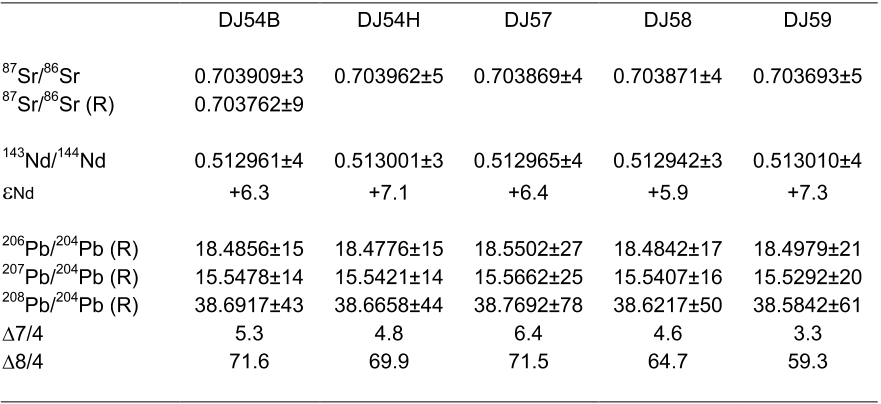A LREE-depleted component in the Afar plume; further evidence from Quaternary Djibouti basalts
Figures (8)

Table 2 (continued).4 5 
Table 2 (continued).4 5 
Table 3 Click here to download Table: Hayy_Table 3nb.doc 
Table 1. Unspiked 40K-40Ar datings of Hayyabley basalts. See text for the analytical 1 procedures. 2 3 
Table 1.5 
Table 4. Sr, Nd and Pb isotopic compositions of Hayyabley basalts (B: bulk rock; R: residue 1 after leaching). See text for the analytical procedures. Δ7/4 and Δ 8/4 denote the deviation (in 2 0/00) of 
Table 4. Sr, Nd and Pb isotopic compositions of Hayyabley basalts (B: bulk rock; R: residue 1 after leaching). See text for the analytical procedures. Δ7/4 and Δ 8/4 denote the deviation (in 2 0/00) of 
Table 3 Click here to download Table: Hayy_Table 3nb.doc
Citations
62 citations
Cites background from "A LREE-depleted component in the Af..."
...…Thirlwall et al., 2004; Kokfelt et al., 2006], the Galapagos [White et al., 1993;Hoernle et al., 2000; Blichert-Toft and White, 2001; Saal et al., 2007], Afar [Furman et al., 2006; Beccaluva et al., 2009; Daoud et al., 2010] and Hawaii [Yang et al., 2003; Frey et al., 2005; Fekiacova et al., 2007]....
[...]
46 citations
45 citations
42 citations
Cites background from "A LREE-depleted component in the Af..."
...Analogues of the Karelian Palaeoproterozoic continental MORB-type tholeiities have been recognized in the North Atlantic and Afar continental flood basalt provinces, where depleted MORB-type tholeiitic basalts are shown to have formed simultaneously with high-Ti basalts (Barrat et al., 2003; Daoud et al., 2010; S ager & Holm, 2011;Waight & Baker, 2012)....
[...]
..., 2012), and dikes (this study) compared with low-Ti tholeiites from the Faroe Islands (S ager & Holm, 2011), depleted basalts from Central East Greenland (Waight & Baker, 2012), LREE-depleted basalts from Central Afar (Barrat et al., 2003; Daoud et al., 2010), Kolbeinsey Ridge and Reykjanes Ridge basalts (PetDB), and global N-MORB (PetDB)....
[...]
...MORB-type continental tholeiitic basalts are thought to have formed as a result of melting of depleted mantle components in mantle-plume source regions (Daoud et al., 2010; S ager & Holm, 2011; Waight & Baker, 2012)....
[...]
..., 1990; Perttunen & Hanski, 2003); Fe^Ti basalts and low-Ti basalts, Faroe Islands (S ager & Holm, 2011); Fe^Ti basalts and depleted basalts, Central East Greenland (Waight & Baker, 2012); LREE-depleted basalts, Central Afar (Barrat et al., 2003; Daoud et al., 2010)....
[...]
References
69 citations
68 citations
"A LREE-depleted component in the Af..." refers methods in this paper
...Ar analyses were performed using the procedures detailed 74 in Yurtmen et al. (2002) and Guillou et al. (2004)....
[...]
68 citations
"A LREE-depleted component in the Af..." refers background in this paper
...…South Red Sea occurrences, which include 818 oceanic ridge segments, Ramad seamount and Zubair and Hanish islands (Barrat et al., 1990, 819 1993; Volker et al., 1993, 1997), (2) submarine basalts from the East of the Gulf of Tadjoura 820 and the Aden Gulf (Barrat et al., 1990, 1993; Schilling…...
[...]
59 citations
"A LREE-depleted component in the Af..." refers background or methods in this paper
...Although a positive Sr anomaly has been observed in a single 243 LREE-depleted basalt, positive Ba and Eu anomalies are missing (Barrat et al., 1990, 1993 244 and unpublished results)....
[...]
...For example, 241 basalts with N to T-MORB affinities are known from the eastern part of the Tadjoura Gulf 242 (Barrat et al., 1990, 1993)....
[...]
...Compositions of LREE-depleted basalts from Hayyabley (average of the samples 1 analysed by ICP-MS), Manda Hararo (average data from Barrat et al., 2003), Ethiopian 2 Plateau (sample E88, Pik et al., 1999), and of a N-MORB from Tadjoura Gulf (sample A3D3, 3 Joron et al., 1980; Barrat et al., 1993)....
[...]
...In the case of basalts emitted by 387 the young oceanic ridges from the Red Sea or the Aden Gulf, major involvement of MORB-388 related sources has been proposed (e.g., Barrat et al., 1990, 1993; Schilling et al., 1992; 389 Volker et al., 1993)....
[...]
...…of LREE-depleted basalts from Hayyabley (average of the samples 846 analysed by ICP-MS), Manda Hararo (average data from Barrat et al., 2003), Ethiopian 847 Plateau (sample E88, Pik et al., 1999), and of a N-MORB from Tadjoura Gulf (sample A3D3, 848 Joron et al., 1980; Barrat et al., 1993)....
[...]
51 citations
"A LREE-depleted component in the Af..." refers background in this paper
...the Hayyabley and Manda Hararo basalts overlie thinned continental crust which is 25-26 km 335 thick (Dugda and Nyblade, 2006), while the depleted plateau basalt sample E88 (Pik et al....
[...]
...In addition, 334 the Hayyabley and Manda Hararo basalts overlie thinned continental crust which is 25-26 km 335 thick (Dugda and Nyblade, 2006), while the depleted plateau basalt sample E88 (Pik et al., 336 1999) is located on normal (ca. 40 km thick) African crust....
[...]